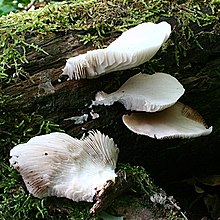Crepidotus applanatus
| Crepidotus applanatus | |
|---|---|

| |
| Scientific classification | |
| Domain: | Eukaryota |
| Kingdom: | Fungi |
| Division: | Basidiomycota |
| Class: | Agaricomycetes |
| Order: | Agaricales |
| Family: | Crepidotaceae |
| Genus: | Crepidotus |
| Species: | C. applanatus
|
| Binomial name | |
| Crepidotus applanatus | |
| Synonyms | |
|
Agaricus applanatus Pers. | |
Crepidotus applanatus is a species of fungus in the family Crepidotaceae. It was first described in 1796 by Christiaan Hendrik Persoon and renamed by Paul Kummer in 1871.[1][2] It is inedible.[3]
Description[edit]
Like other Crepidotus, it has brown spore powder. It grows on deciduous wood, to which it is attached at the side by at most only a rudimentary stem (it is "pleurotoid"). The cap grows up to 5 cm across and is hygrophanous, white to ochraceous when damp and drying whitish. The spores, around 5 - 6 µm, are almost spherical and warty. It is distinguished from the very similar Crepidotus stenocystis by the shape of the Cheilocystidia (clavate and unbranched) and the habitat on broad-leaf timber.[4][5]
| Gills on hymenium | |
| Lacks a stipe | |
| Spore print is brown | |
| Ecology is parasitic | |
| Edibility is inedible | |
References[edit]
- ^ "Crepidotus applanatus, Flat Oysterling, identification". www.first-nature.com.
- ^ "Crepidotus applanatus (MushroomExpert.Com)". www.mushroomexpert.com.
- ^ Miller Jr., Orson K.; Miller, Hope H. (2006). North American Mushrooms: A Field Guide to Edible and Inedible Fungi. Guilford, CN: FalconGuide. p. 286. ISBN 978-0-7627-3109-1.
- ^ Knudsen, Thomas; Vesterholt, J., eds. (2018). Funga Nordica Agaricoid, boletoid, clavarioid, cyphelloid and gasteroid genera. Copenhagen: Nordsvamp. p. 979. ISBN 978-87-983961-3-0.
- ^ Eyssartier, G.; Roux, P. (2013). Le guide des champignons France et Europe (in French). Belin. p. 984. ISBN 978-2-7011-8289-6.
